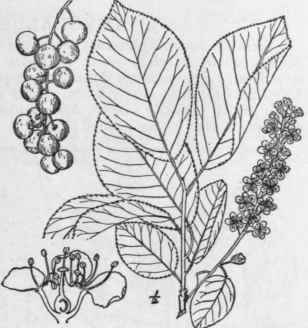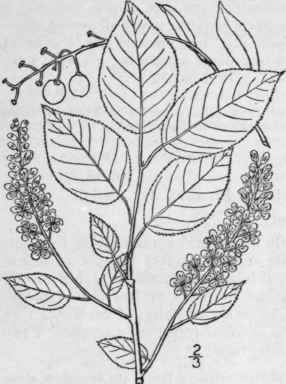1. Prunus [Tourn.] L. Sp. Pl. 473. 1753. Part 6
Description
This section is from the book "An Illustrated Flora Of The Northern United States, Canada And The British Possessions Vol2", by Nathaniel Lord Britton, Addison Brown. Also available from Amazon: An Illustrated Flora of the Northern United States, Canada and the British Possessions. 3 Volume Set..
1. Prunus [Tourn.] L. Sp. Pl. 473. 1753. Part 6
15. Prunus Pennsylvánica L. F. Wild Red Or Pigeon Cherry
Fig. 2423
Prunus pennsylvanica L. f. Suppl. 252. 1781. Cerasus pennsylvanica Lois. Nouv. Duham. 5: 9. 1812.
A small tree, with maximum height of about 35o, and trunk diameter of 1 1/2°, sometimes shrubby. Leaves oval or lanceolate, acute or acuminate at the apex, mainly rounded at the base, glabrous and shining on both sides, serrulate, rather slender-petioled; flowers white, in lateral, corymbose, peduncled or sessile leafless clusters, unfolding with the leaves; pedicels slender, glabrous, 6"-12" long; drupe globose, red, 2"-3" in diameter, without bloom, its flesh thin and sour, its stone globular.
In rocky woods, and clearings, Newfoundland to Georgia, British Columbia and Colorado. Woods soft, light brown; weight per cubic foot 31 lbs. Dogwood. Bird-, red-, fire- or pin-cherry. April-June. Fruit ripe in August.
16. Prunus Mahàleb L. Mahaleb. Perfumed Cherry
Fig. 2424
Prunus Mahaleb L. Sp. Pl. 474. 1753.
Cerasus Mahaleb Mill. Gard. Dict. Ed. 8, no. 4. 1768.
A small tree or shrub, with maximum height of about 25o and trunk diameter of 1° generally flowering when but a few years old. Bark pale, smooth; leaves petioled, ovate, abruptly acute at the apex, rounded or slightly cordate at the base, glabrous on both sides, denticulate, fragrant; flowers white, about 5" broad, in corymbs borne on short leafy branches of the season, unfolding with the leaves; drupe reddish-black, globose or globose-ovoid, about 4" long, the flesh thin, the stone slightly flattened.
Roadsides and waste places, Ontario to New York, Pennsylvania and Delaware. Adventive from Europe. Wood hard, brown. Used in Europe for cabinet making. April-May. Fruit ripe July.

2. PÀDUS Mill. Gard. Dict. Abr. Ed. 4. 1754.
Trees or shrubs, with alternate deciduous leaves and small white flowers in narrow racemes terminating leafy branches of the season. Petals spreading. Stamens 15-20. Calyx-tube bell-shaped, with 5 short sepals. Style terminal, simple, the stigma flattish. Drupe small, globose, red to purple or black, the exocarp fleshy, the endocarp hard, smooth. [Greek name for the European species.]
About 15 species, natives of the northern hemisphere. Besides the following, 4 occur in the Southern States and 1 in northwestern America. Type species: Prunus Padus L.
Sepals deciduous; teeth of the leaves slender; shrubs or small trees. | ||
Fruit very astringent; leaves thin. | 1. | P. nana. |
Fruit sweet, little astringent; leaves thick. | 2. | P. melanocarpa. |
Sepals persistent; leaves coarsely toothed; large tree. | 3. | P. virginiana. |
1. Padus nana (Du Roi) Roemer. Choke Cherry. Fie. 2425.
Prunus nana Du Roi, Harbk. Baumz. 12: 194. f. 4.
1772. Padus nana Roem. Arch, 12: 38. 1797.
A shrub, 2°-10° high, rarely a small tree, with gray bark. Leaves thin, obovate to ovate or oval, abruptly acute or acuminate at the apex, rounded at the base, glabrous or somewhat pubescent on the lower surface, sharply or doubly serrulate with slender teeth; petioles with several glands; flowers white, 4"-5" broad, in erect or spreading mainly loosely-flowered racemes; petals suborbicular; pedicels 2"-3" long, drupe red to nearly black, rarely yellow, globose, 4"-5" in diameter, very astringent; stone globular.
Along river-banks and in rocky situations, Newfoundland to Manitoba, Georgia and Texas. April-May. Fruit ripe in July or August.


Continue to:


